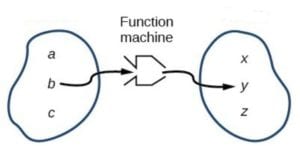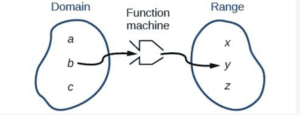The term “function” is important in the field of quantum mechanics because is it the basis of the key term “wave function.” What is a function?
“Function” Defined

In mathematics, x + 2 = y is an example of a function. A function is a certain type of equation. Specifically, a function is an equation that, for every number inputted into the equation, a single number is outputted. In the example, x + 2 = y, for every x inputted, there is only one output y, and it is larger than x by 2. So, x + 2 = y meets the definition of a function.
Here’s another example: Is the equation ± √x = y a function? Let’s say x=4, what is the output y? The output can be either +2 or -2. If we input 4 into this little machine, we get two possible outputs. So, ± √x = y does not qualify as a function.
To put the definition into other words, a function is a little computational machine. Each number inputted into the machine maps to only one possible outputted number. A function is a rule that tells you that if you start with x, you will get only a single value of y. For quantum physics, this is really all you need to know about functions. The remainder of this article is about technical details.
Other Ways to Write Functions
Another example of a function is 2x = y. If x = 3, the output is 6 and only 6. This function can also be written as f(x) = 2x. Here f stands for “function.” This is read “f of x equals 2x.” If we’re working with more than one function, other letters can be used. For example, we might want to write two functions: f(x) = 2x and g(x) = x + 2.
Functions can also be expressed as sets of numbers. For example, we can say that Function f maps the set of the whole positive numbers {1, 2, 3, etc.} to the set {1+2, 2+2, 3+2,…} etc.
A function can be stated in English words. For example: the function f(x) equals 3 times x. Using numbers, this function would be written: f(x)=3x.
Or a function can be stated partly in English words. Here’s a more complicated function in which a function is defined with two different rules: f(x) = 3x if x ≥ 0 and f(x) = 2x if x < 0. Since x always maps to a single y value, this is a legitimate function, but one that is stated with two different rules.
Two Meanings to the Term “Function”
Let’s say that we’re working with the function f(x) = x + 2. We can say that f(x) refers to the little machine: add 2 to x to get y. Or we can say that f(x) refers only to the answer y. The difference is subtle, but this slight difference in meaning can confuse. When working with functions, it’s helpful to be aware that either meaning can be assigned to f(x).
Domain of a Function

We can restrict the inputs to a function. We can make a rule that only certain numbers may be fed into the machine. For example, let’s say Maria tells her daughter that she will match any deposit that the daughter makes to her college savings account, with one condition: the deposit is less than $1,000. Maria’s daughter can calculate how much her savings will increase every time she deposits money in the bank using this function: f(x) = 2x when x < $1,000.
The numbers that may be fed into a function are called its “domain.” The domain of Maria’s function is the positive numbers that are less than 1,000. This is written, domain = (0, 1000). The round parentheses mean that all the numbers between 0 and 1000 are included except 0 and 1,000.
In this case, the domain of the function has been limited by a parental rule. There is no inherent mathematical reason for limiting the domain to numbers less than 1,000. But some functions will work with only certain domains; there are mathematical reasons for limiting the domain. For example, consider the function f(x) = 1/x. It won’t work if x = 0. We are not allowed to divide a number by 0. The solution to, for example, 1/0 is “undefined.” To prevent a function from representing undefined amounts, we have to limit its domain. The g function will work for all numbers except 0. The domain of g(x) = (-¥, 0) and (0, +¥). Again, the rounded parentheses indicate that the endpoints (the infinities and 0) are excluded from the domain. Infinity is excluded because it is not an actual number; it is the statement that we can include additional numbers into the domain indefinitely.
Range of a Function
The range of a function is the group of numbers that is outputted by a function. Maria’s function
f(x) = 2x has the range: even numbers greater than 0 and less than 1,000.
